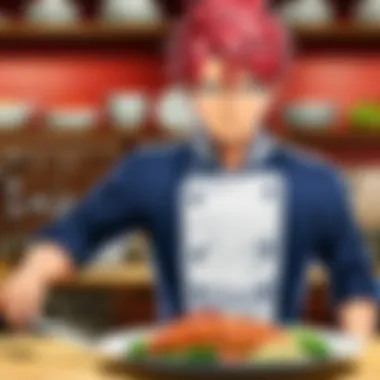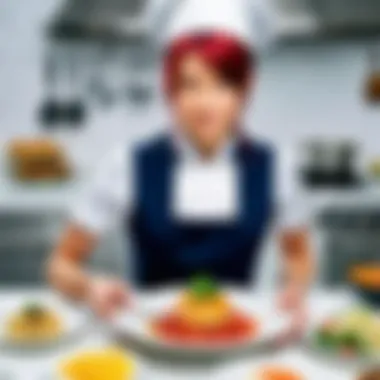Food Wars: The Third Plate - A Deep Dive into Culinary Art


Intro
In this article, we will dissect the intricate layers that make up the narrative, character arcs, and thematic undercurrents that Food Wars presents in its third installment. From the heart-pounding Shokugeki to the subtle symbolism embedded within the meals, this is a deep dive into how culinary arts serve as both battleground and bridge among the characters. So, whether you are a seasoned aficionado or a newcomer curious about what all the fuss is about, let's embark on this flavorful journey together.
Overview of Food Wars
Understanding the premise of Food Wars is crucial for anyone eager to grasp its complex narrative and rich thematic tapestry. This anime series is not just about culinary competitions; it embodies a profound exploration of passion, ambition, and the relentless pursuit of culinary excellence. Each season builds upon the last, with escalating stakes and deepening character arcs that resonate well beyond the plates served.
Preface to the Series
Food Wars, originally known as Shokugeki no Soma, debuted in 2015 and quickly captured the imagination of anime fans worldwide. Set in the prestigious Totsuki Culinary Academy, the series follows Soma Yukihira, a young chef determined to prove his worth in an institution known for producing top-tier culinary talents. From the very first episode, viewers are introduced to a competitive environment where cooking is akin to warfare. The term "Shokugeki" refers to these high-stakes cooking challenges, where participants face off to not only showcase their culinary skills but also to defend their honor or stake their pride.
What makes the series unique is its ability to blend intense cooking battles with the personal growth of its characters. Soma’s journey is marked by challenges that test not just his cooking abilities, but also his creativity and resolve. The narrative unfolds with an impressive cast, each contributing to the overarching theme of perseverance. As spectators, we are drawn into the world of flavors, techniques, and the high stakes of culinary competition.
Significance of the Third Plate
The Third Plate serves as a pivotal installment that escalates the drama and excitement of the series. It introduces new challenges that enrich the storyline while adding layers to the character development we’ve grown to cherish. Here, we see Soma and his friends grappling with larger themes: identity, friendship, and the essence of what it means to be a chef.
In this season, the culinary challenges become even more significant as they reflect broad societal issues, making them relatable to a wider audience. This season not only challenges the abilities of the characters but also delves into the philosophical aspects of cooking—prompting viewers to reflect on the intent behind every dish.
Ultimately, the Third Plate is not just a continuation of the narrative. It’s a deep dive into the heart of culinary arts—a season that prompts its audience to question what it means to truly create.
"Cooking is not just about taste; it’s an art that combines culture, emotion, and personal expression."
As we navigate through the intricacies of this anime, keeping a keen eye on such elements enriches our viewing experience while highlighting Food Wars as a significant cultural phenomenon.
Character Dynamics
Protagonist Evolution
Development of Soma Yukihira
Soma Yukihira’s development stands as a cornerstone of the series, showcasing his relentless pursuit of culinary excellence. From a brash, ambitious young chef to a more refined and strategic competitor, Soma's journey encapsulates personal growth. His key characteristic is his unyielding determination, which propels him to tackle the challenges within the competitive cooking milieu. This evolution is significant for understanding the broader themes of resilience and ambition that permeate the story.
The unique feature of Soma’s development is his ability to learn and adapt quickly. This flexibility not only sets him apart as a cook but also allows him to forge meaningful connections with his peers. By constantly seeking feedback and incorporating lessons from failures, his character embodies the essence of learning both in cooking and life. This aspect can be highly beneficial as it encourages viewers to reflect on their own growth experiences, making Soma a relatable and engaging protagonist.
Challenges Faced and Overcome
The challenges that Soma faces are pivotal in shaping his character and his journey. Each competition he enters brings not only culinary hurdles but emotional tests that push him beyond his limits. The element of challenge serves as a mechanism for conflict—a vital driver in storytelling that keeps viewers invested in the outcome. An interesting trait here is how these challenges are not merely obstacles but profound learning opportunities that stir character development and pave the way for breakthroughs.
What sets Soma’s challenges apart is their diversity; they range from rival confrontations to internal struggles with self-doubt. Overcoming these obstacles often leads to tangible growth and culminates in personal victories that resonate well with the audience. However, one disadvantage is that these constant high-stakes scenarios can sometimes make his journey feel overwhelming, which might detract from the exploration of secondary characters.
Supporting Characters
Role of Erina Nakiri
The advantage of focusing on Erina’s role is her narrative as a foil to Soma. While Soma represents raw talent and instinct, Erina embodies rigorous training and high expectations, enriching the thematic discourse on what it means to be a chef in today’s world. However, her character development is slightly hindered at times, overshadowed by Soma’s overpowering presence in narrative arcs.


Impact of the Elite Ten
The Elite Ten serves as a representation of culinary authority and the pinnacle of achievement within the series, influencing various character arcs significantly. Their presence creates a competitive environment that propels Soma and his companions to aspire toward higher standards. Each member of the Elite Ten comes with unique cooking philosophies and skills that challenge the standards of what it means to be a chef. Their significance lies in initiating pivotal plot points that push both Soma and Erina out of their comfort zones.
What makes the Elite Ten notable is how they serve as benchmarks for growth. They not only provide exciting competition but also catalyze character revelations and transformations. However, one downside could be the tendency of the narrative to lean heavily on them, which, at times, may make the storyline feel a bit formulaic as the focus becomes too centered on their power and influence.
Thematic Elements
Culinary Philosophy
Passion vs. Technique
The debate of passion versus technique in cooking is a profound theme in the series. Soma Yukihira embodies passion — his carefree approach to cooking, driven by love for food rather than rigid rules, demonstrates how emotional investment can produce outstanding results. Passion is characterized by creativity and spontaneity, allowing chefs to break conventional boundaries.
On the flip side, technique is about precision, consistency, and mastery of skills, qualities embodied by characters such as Erina Nakiri, whose high standards demand rigor in every dish.
This duality is crucial; it prompts viewers to contemplate the balance between emotional engagement and technical skill. An overreliance on passion can lead to chaos in a kitchen, while strict adherence to technique may stifle creativity. Consequently, the interplay between these two elements not only spices up the narrative but aligns with real-world culinary experiences.
The Art of Innovation
The Art of Innovation resonates deeply within the context of the show, reaffirming that culinary excellence often stems from the willingness to experiment and evolve. Soma's innovative spirit challenges traditional norms. His unique approach to ingredients and flavors illustrates how experimentation can yield surprisingly successful dishes.
What puts this theme in the spotlight is that innovation isn't merely about novel techniques; it’s about embracing change and personal growth. For example, characters evolve through exposure to unfamiliar cuisines and cooking styles, breaking them out of their comfort zones. However, innovation also carries risks — not every daring dish lands successfully. This theme invites audiences to reflect on their own experiences with creativity and adaptation, serving as a metaphor for various life challenges.
Competition as a Metaphor
In Food Wars, competition transcends the kitchen, becoming a powerful metaphor for life’s trials and tribulations. The Shokugeki, or cooking duels, are not just culinary contests; they are avenues for personal revelation and growth.
Shokugeki as Life Lessons
Through the lens of Shokugeki, characters learn invaluable lessons about resilience, risk, and striving for excellence. It’s evident that cooking is not merely an art but also a method for confronting personal demons. For instance, each challenge faced reveals deeper aspects of the character’s psyche, including fear, self-doubt, and determination. This narrative choice invites viewers to draw parallels between their own conflicts and the competitive spirit of cuisine.
The intensity of these competitions serves to heighten emotional stakes, making victories and defeats resonate on a personal level. The unique feature here is that these cooking battles reflect larger societal issues, embodying the struggle for identity, acceptance, and success. Through testing one’s limits in the kitchen, characters learn vital life lessons applicable beyond the culinary realm.
Transformation through Adversity
Transformation through Adversity serves as a glowing thread that runs throughout the series. Overcoming hardship is fundamental to character arcs in the Third Plate, where setbacks lead to profound self-discovery and strength. Characters like Soma transform not only through victories but by embracing failures.
Adversity often becomes a catalyst for introspection and redefining priorities. It’s realistic; many people face challenges that forge their identities and future paths. This thematic exploration is powerful, allowing audiences to empathize with characters who weather storms in pursuit of their passions.
Symbolism in Food Preparation
The Role of Ingredients
Cultural Significance
When examining cultural significance, it’s essential to acknowledge how ingredients represent various identities and traditions. In the series, specific dishes are often tied to regions or historical contexts, capturing the essence of Japanese culture and the importance of culinary heritage. This aspect is crucial for portraying the characters’ backgrounds, creating a narrative thread that intertwines their personal stories with cultural history.


The key characteristic of this cultural representation is how it fosters a sense of belonging and pride among characters. Many chefs, including Soma Yukihira, draw on traditional recipes while infusing them with their personal flair, representing the balance between homage and innovation. This fusion serves as a celebration of culinary evolution, bridging past and present. By incorporating culturally significant ingredients, Food Wars not only entertains but also educates viewers about the rich tapestry of culinary arts. However, the challenge lies in maintaining authenticity while experimenting with flavors, which can lead to criticism from purists within the culinary community.
- Advantages: Strengthens cultural ties and appreciation of heritage.
- Disadvantages: May lead to debates over what represents a dish authentically.
Seasonal and Local Sourcing
On the other hand, the focus on seasonal and local sourcing in food preparation underscores the sustainability and freshness of ingredients. By emphasizing local produce, Food Wars advocates for the use of ingredients that enhance flavor and quality. This practice enriches dishes by incorporating seasonal variations, allowing chefs to showcase their adaptability and creativity.
Highlighting regional ingredients aligns with current trends in culinary practices, making it a highly relevant topic. Chefs' reliance on local sources not only reduces carbon footprints but also fosters community engagement. Unique to this approach is the notion that food must change with the seasons, heightening its significance. This dynamic reflects the evolving nature of both cuisine and the chefs themselves, serving as a continual reminder of the connection between nature and culinary art.
- Advantages: Promotes sustainability and freshness; fosters local economies.
- Disadvantages: Limited availability of certain ingredients can constrain creativity.
Presentation and Context
Aesthetics of the Dish
Food’s visual appeal is often what first draws diners in. In Food Wars, the aesthetics of a dish plays a vital role in how it is perceived and appreciated. The arrangement of ingredients, the use of colors, and overall presentation are elevated to an art form, showcasing the chef’s skill and attention to detail. This visual component serves to heighten the stakes in competitions, as a well-presented dish can often sway judges before tasting even begins.
A notable characteristic of food aesthetics is its ability to evoke feelings and set expectations. When a dish is beautifully arranged, it signals to the eater that it is crafted with care and expertise, making it all the more enticing. This focus on aesthetics also challenges characters to constantly innovate their presentation styles, pushing boundaries and defying norms.
- Benefits: Engages the audience, creates excitement for tasting experiences.
- Disadvantages: Can overshadow flavor if not carefully balanced.
Emotional Responses to Food
The emotional ties humans have with food are profoundly explored in Food Wars. Dishes evoke memories, nostalgia, and connections with family and friends. Emotional responses to food can be powerful motivators for characters, propelling them to achieve culinary greatness or rewrite their pasts. The interplay between taste and sentiment is palpable; a single bite can trigger a flood of memories, reinforcing the power of food as a narrative device.
A key characteristic of exploring these emotional responses is the connection to character development. As chefs face challenges, their relationship with food reflects their inner struggles and triumphs, making their culinary journey deeply personal. Moreover, this emotional aspect emphasizes that food is not merely for sustenance; it is a medium for shared experiences, resilience, and growth.
- Benefits: Enhances character depth, fosters audience empathy.
- Disadvantages: Risk of cliché if emotional connections are overused without fresh perspectives.
Plot Arcs in the Third Plate
The plot arcs in the Third Plate of Food Wars serve as the backbone of the series, intertwining character progression with intense culinary rivalries. Each competition not only acts as a stage for culinary prowess but also as a catalyst for character development, revealing intricate backstories and motivations. The stakes are frequently raised, compelling viewers to engage deeply with the characters' journeys and the outcomes of their battles. Whether these arcs bring out the best or the worst in the characters, they cultivate an atmosphere ripe for growth and evolution within the context of cooking.
Major Competitions
Key Battles and Their Stakes
The key battles in the Third Plate feature high-stakes Shokugekis that captivate the entire series. Each competition is not just about who can cook better but also involves personal honor, reputation, and the relentless pursuit of culinary excellence. These confrontations are charged with emotions, as many battles set the stage for characters to showcase not only their culinary skills but also their personal philosophies towards food and cooking.
A significant aspect that makes these battles so engaging is their unpredictability. Viewers are often left on the edge of their seats, as even a small mistake can tip the scales in these high-pressure environments. The unique feature of each key battle lies in its thematic representation of culinary artistry, where the stakes often resonate with the character’s internal struggles. This connection not only adds depth to the narrative but also draws the audience closer to the characters, allowing for a richer viewer experience.
Consequences of Defeat
Defeat in Food Wars carries weight far beyond just a loss in culinary skill; it affects the characters' paths dramatically. When a character loses a crucial Shokugeki, the fallout can be devastating. For some, it leads to self-doubt and a crisis of identity, while others may rise from failure with renewed vigor and motivation. This aspect emphasizes the theme that failure is not the end but rather a part of growth and enlightenment in the culinary world.
What makes this a popular choice for the narrative in the Third Plate is the rich exploration of these consequences. The emotional turmoil following a loss is palpable, often leading characters to confront their deepest fears and insecurities. As they navigate the repercussions of defeat—whether it's shame, regret, or determination—the audience witnesses their transformation. This adds significant weight to the plot arcs, illustrating how vital each battle is not only for the competition but for the personal evolution of the characters involved.


Character Revelations
Backstories Unveiled
The backstories of key characters take center stage in the Third Plate, adding layers to their current actions and motivations. As the series unfolds, these revelations provide much-needed context, helping viewers understand why characters approach cooking and competition in particular ways. Sometimes, the audience learns of past experiences that shaped their current culinary philosophies. This background creates a sense of empathy and connection with the characters.
What sets these backstories apart is how seamlessly they integrate with ongoing events. They often emerge at pivotal moments—during intense culinary battles, for instance—providing insight into why a character may execute a specific dish or tactic. This storytelling technique proves beneficial as it not only enriches the viewers' understanding but also elevates the impact of each character's journey.
Personal Growth Through Conflict
Conflict is pivotal in the Third Plate, driving personal growth for many characters. Each encounter, whether friendly or hostile, forces characters to confront their weaknesses and push their limits. This aspect reflects a core theme of the anime: growth through adversity. The more pressing the challenge, the more likely a character finds a path to self-improvement.
Cultural Influences
Japanese Culinary Traditions
Influence of Regional Cuisines
Understanding these regional nuances is key for both the characters and viewers. The show's vibrancy shines through these elements, making it rich and educational. The key characteristic here is authenticity, which brings a sense of pride and connection to the roots of the culinary art form. However, focusing solely on regional cuisines might overlook the innovative aspects and modern techniques that are just as vital.
Integration of Modern Techniques
The incorporation of contemporary culinary methods into traditional Japanese cooking serves as another crucial element in this narrative. Techniques such as sous-vide cooking or molecular gastronomy break away from classic practices, offering fresh perspectives on Japanese cuisine. These modern approaches allow characters to push boundaries, combine flavors, and present food in striking ways.
The combination of tradition and innovation creates a dynamic culinary experience, showcasing the creative processes that chefs undergo. This duality serves educational purposes as it illustrates that cooking isn't quite static. However, it often raises the question of whether straying too far from tradition dilutes the essence of the cuisine itself.
Global Culinary Trends
Fusion and Experimentation
Fusion's appeal lies in its versatility and inclusiveness. It's popular because it creates dialogues between different cultures. Yet, the challenge remains in maintaining respect for the original culinary forms while innovating. Viewers are left pondering whether some ingredients truly belong together or if it's a culinary masquerade.
Reflection of Contemporary Issues
With its focus on modern challenges in the culinary world, the anime illustrates a connection between food choices and their impact on society. This relevance elevates the narrative beyond mere competition, embedding deeper discussions about ethics and values in cooking. The unique feature of this thematic element is that it invites the audience to consider their roles as consumers in a globalized world.
"Food is not just an art; it’s a reflection of society itself."
The End
Impact on the Anime Landscape
The influence of Food Wars extends beyond mere entertainment; it sheds light on the multifaceted nature of anime as a powerful narrative medium. In this third installment, audiences witness a shift in storytelling that emphasizes depth and nuance. The battles faced by Soma Yukihira and his peers aren’t just about food; they explore deeper existential themes.
Some specific elements that highlight its impact include:
- Portrayal of Culinary Arts: Each episode can almost be treated as a mini-masterclass in gastronomy, with intricate details about techniques and ingredient choices that elevate food appreciation.
- Character Complexity: The characters evolve significantly, grappling with their insecurities and ambitions. Soma's journey encapsulates the essence of growth, making viewers reflect on their own paths.
- Cultural Dialogue: The series engages viewers in a dialogue about culinary traditions versus modern innovation, thus opening pathways to discussions on culture and identity.
This blend of culinary arts with character-driven narratives has inspired other anime and manga, marking a trend where food becomes more than just sustenance. It transforms into a means of self-discovery and cultural expression.
Final Thoughts on the Third Plate
The significance of this installment lies in its ability to encapsulate the ethos of culinary arts within the realm of competitive cooking.
"Food is not just what you eat; it’s a canvas, a story, a way of sharing culture and personal struggles."







